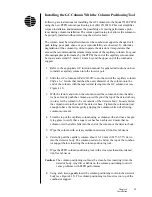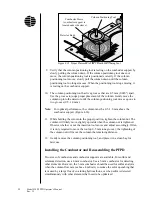
62
Model 5380 PFPD Operator’s Manual
Rev. 3.1
Optimizing PFPD Detectivity and Selectivity
Besides the combustor gas composition, several other PFPD parameters can be
used to optimize the PFPD’s response to one or more analytes. These include
optical filter, PMT, gate settings, combustor diameter, and detector temperature.
Since the two output signal channels operate independently, different start and stop
times can be specified for their gates. Thus, the detector can be optimized for more
than one condition. For example, the gate start and stop times can be set to maxi-
mize detectivity by including most of the analyte’s chemiluminescence lifetime
within the gate. (See Appendix B for calculation of detectivity and sensitivity of
sulfur and phosphorus modes.) Alternately, gate times can be set to maximize
selectivity by limiting the gate width to a segment of the analyte’s chemilumines-
cence lifetime that is independent of interference from other chemiluminescence
sources. It may not be possible to set gates for two elements (e.g. phosphorus and
sulfur) so that there is no gate overlap because this may excessively compromise
detectivity for one or both elements. When gate overlap is inevitable, dual gate
techniques may have to be used to increase selectivity (see Appendix C for detailed
discussion of the dual gate technique). Maximum sensitivity and selectivity are
obtained with the appropriate filters and PMTs to match a given application. For
assistance in properly configuring the PFPD to a specific application, call OI
Analytical’s Technical Support Department at (800) 336-1911 or (979) 690-1711.
Optimizing for Detectivity
Maximizing Phosphorus Response
The PFPD’s detectivity for phosphorus can be maximized in the following way:
1. Install a 3-mm combustor. (See “Installing the Combustor and Reassembling
the PFPD” in Chapter 4.)
2. Since HPO* is the species emitting the chemiluminescence, reduce the H
2
to
Air 1 ratio of the combustor gas mixture relative to the optimal setting for
sulfur by increasing the Air 1 flow rate.
3. Increase the detector temperature to 300°C. The uniformity of the phosphorus
response will decrease below this temperature while detectivity for phospho-
rus may decrease to above about 325°C. Therefore, the detector temperature
should not be set any higher than that required to preserve the chemilumines-
cence peak shape and lower than that needed to maintain column integrity.
4. Adjust the fine adjust needle valve so that the needle valve is half a turn
counterclockwise from the point in which the PFPD goes out of tick-tock.
5. In the Gate Parameters screen, set start and stop times of the integration gate
(recommend 4–5 ms and 15 ms, respectively) to optimize phosphorus
detectivity. If the gas flows are properly optimized, the “tail” of the phospho-
rus emission should extend out to 12–15 ms (see Figure 5.4).
6. Optimize the PMT voltage and trigger level. See step 14 of “Starting the
PFPD System” in this chapter.
Содержание 5380
Страница 89: ...84 Model 5380 PFPD Operator s Manual Rev 3 1 Notes...
Страница 95: ...90 Model 5380 PFPD Operator s Manual Rev 3 1 Notes...
Страница 99: ...94 Model 5380 PFPD Operator s Manual Rev 3 1 Notes...
Страница 107: ...102 Model 5380 PFPD Operator s Manual Rev 3 1 Notes...
Страница 117: ...112 Model 5380 PFPD Operator s Manual Rev 3 1 Notes...
Страница 125: ...120 Model 5380 PFPD Operator s Manual Rev 3 1 Notes...
Страница 133: ...P O Box 9010 College Station TX 77842 9010 Tel 979 690 1711 FAX 979 690 0440 www oico com...
















































